弹性网格壳分析的等效壳模型
IF 6.4
1区 工程技术
Q1 ENGINEERING, CIVIL
引用次数: 0
摘要
本研究提出了一种新的框架来模拟弹性网格壳,特别是它们的部署阶段,使用从棒的特殊Cosserat理论衍生的连续体壳模型。这种方法在离散的基于杆的网格壳结构和连续的壳表示之间实现了能量等效,从而能够推导出准确反映结构行为的本构参数。数值模拟验证了该模型的卓越精度,与传统的离散梁模型相比,其最大均方根误差约为2%。在一个现实世界的结构上进行的实验验证,即托莱多2.0网格壳,进一步证实了模型的预测能力。提出的方法为网格壳设计的早期阶段提供了一种高效和通用的工具。它允许快速评估结构性能,从而显着减少计算开销,同时保持高精度。本文章由计算机程序翻译,如有差异,请以英文原文为准。

An equivalent shell model for elastic gridshell analysis
This study presents a novel framework for modelling elastic gridshells, and particularly their deployment phase, using a continuum shell model derived from the Special Cosserat Theory of rods. Such an approach enforces energetic equivalence between discrete rod-based gridshell configurations and a continuum shell representation, enabling the derivation of constitutive parameters that accurately reflect the structural behaviour. Numerical simulations validate the model’s remarkable accuracy, achieving a maximum percentage root mean square error of about 2% when compared to traditional discrete beam models. Experimental validation on a real-world structure, the Toledo 2.0 gridshell, further confirms the model’s predictive capability. The proposed methodology provides an efficient and versatile tool for the early stages of gridshell design. It permits rapid assessment of structural performance, thus significantly reducing computational overhead while maintaining high accuracy.
求助全文
通过发布文献求助,成功后即可免费获取论文全文。
去求助
来源期刊

Engineering Structures
工程技术-工程:土木
CiteScore
10.20
自引率
14.50%
发文量
1385
审稿时长
67 days
期刊介绍:
Engineering Structures provides a forum for a broad blend of scientific and technical papers to reflect the evolving needs of the structural engineering and structural mechanics communities. Particularly welcome are contributions dealing with applications of structural engineering and mechanics principles in all areas of technology. The journal aspires to a broad and integrated coverage of the effects of dynamic loadings and of the modelling techniques whereby the structural response to these loadings may be computed.
The scope of Engineering Structures encompasses, but is not restricted to, the following areas: infrastructure engineering; earthquake engineering; structure-fluid-soil interaction; wind engineering; fire engineering; blast engineering; structural reliability/stability; life assessment/integrity; structural health monitoring; multi-hazard engineering; structural dynamics; optimization; expert systems; experimental modelling; performance-based design; multiscale analysis; value engineering.
Topics of interest include: tall buildings; innovative structures; environmentally responsive structures; bridges; stadiums; commercial and public buildings; transmission towers; television and telecommunication masts; foldable structures; cooling towers; plates and shells; suspension structures; protective structures; smart structures; nuclear reactors; dams; pressure vessels; pipelines; tunnels.
Engineering Structures also publishes review articles, short communications and discussions, book reviews, and a diary on international events related to any aspect of structural engineering.
 求助内容:
求助内容: 应助结果提醒方式:
应助结果提醒方式:


